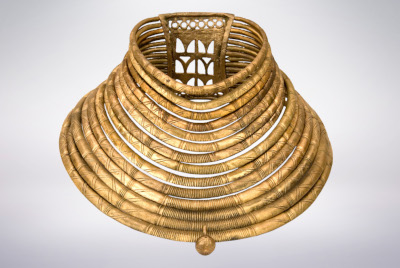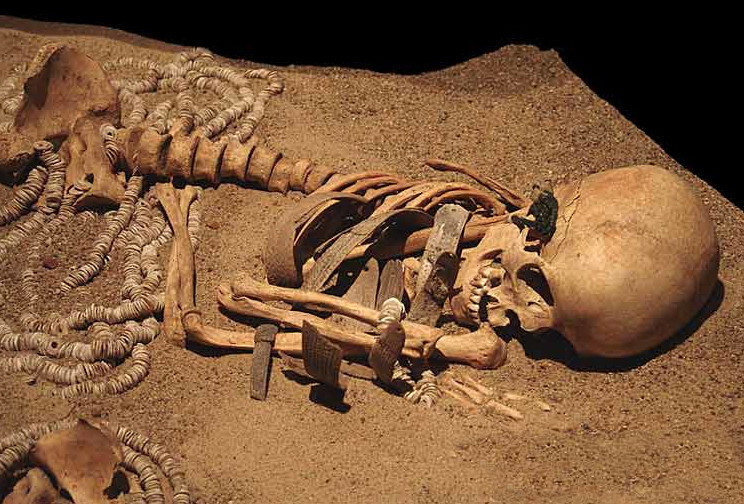Exhibitions
Departments
NEW STONE AGE
The earliest farmers, monumental tombs, stone battleaxes
The dawn od the next afe, known as the Neolithic, is marked by the emergence of alien population groups, pursuing an entirely different way of life – dependent on agriculture – amidst hunter-gatherer societies.
The idea of Neolithization – a term used for the set of characteristics, distinguishing the new type of societies – was born about 10 000 years ago in several areas of the Middle East and South Asia. Spreading slowly, it reached the furthest parts of Europe and brought such economic changes as the production of food by domesticating wild cereals, other plants as well as wild animals, and their successive cultivation and breeding. These fundamental economic transformations occasioned changes in the system of social organization and beliefs, and made people adopt a sedentary life. Other new developments included novel structure types (more robust houses and a functional division of their interiors), previously unknown tools and utensils such as pottery vessels, flint and stone implements (axes, axe-hammers, chisels and sickles) as well as the advancement of weaving.
Early farmers reached the lands of today’s Poland in the 6th millennium BC through the Moravian Gate from cultural centres south of the Carpathian Mountains. They settled on fertile loess and chernozem soils in Little Poland (Małopolska), Silesia, Kuyavia and on the Chełmno and Pyrzyce lands. In Greater Poland, they arrived not much later, most probably crossing Kuyavia and Silesia. Admittedly, we know of many traces of penetration by the earliest farmers, but the remains of more stable settlements date back only to the middle of the 5th millennium BC. The long-lasting settlement brought together the worlds of farmers and hunter-gatherers and made their cultures pervade each other. This, in turn, caused the Neolithic idea to spread over ever-greater areas.
The exhibition features a reconstruction of a settlement occupied by the earliest farmers from about 4500 BC, the remains of which were excavated in Racot, Kościan district. The settlement comprised two pairs of long houses situated next to a river valley. Each house (measuring approx. 50 ×12 m or 165 × 40 ft) was built of oak posts, fastened in a foundation trench. The walls were often filled with wattle and daub and then whitewashed.
The basic means of subsistence at that time was agriculture and animal husbandry. Domesticated animals (sheep, goats, cows and pigs) resembled their wild ancestors, e.g. the aurochs and boar. They were raised for food (meat, milk), making clothes (leather, wool) and tools (bones). The Neolithic people in Greater Poland cultivated different varieties of wheat, barley and millet.
The exhibition shows also a reconstruction a rare kind of burial discovered in the lands of today’s Poland.
This so-called princesses’ grave was unearthed at Krusza Zamkowa, Inowrocław district, and it dates back to the same time as the settlement in Racot. A woman who died at the age of 25-30 years was equipped with ear wraps of copper and calcite beads, a bracelet of freshwater mussle shells, a hip belt consisting of several strings of shell beads and over a dozen richly ornamented antler armlets. Buried in the same grave, a girl (7-8 years old) was given a diadem made of copper beads and two-piece spiral pendants and shell beads, a necklace of copper plates, antler armlets and a hip belt of several strings of shell beads. The find is on loan from the Institute of Prehistory, Adam Mickiewicz University, Poznań.
During the three thousand years of the Neolithic many cultural and civilization changes occurred. Populations settling Greater Poland joined the huge Neolithic cultural community that covered a vast portion of the European Lowland – from the Netherlands to western Ukraine and from south Scandinavia to as far as Bohemia. In the Neolithic, cultural processes took a similar course there, which must have been a result of close interregional contacts. The processes were driven by the demand for stone and flint raw materials and amber as well as by cultural stimuli from beyond the Carpathians. It was there that under the influence of Balkan cultures, centres dependent inter alia on the processing of non-ferrous metals (copper and gold) flourished.
As a result of an impact coming from many directions and migration of populations from adjacent lands, Greater Poland witnessed the development of farming, pastoral and hunter-gatherer cultures, using all types of the environment. They differed in the social organization forms and beliefs that were usually tied to the dominant type of economy. This is manifested in the differences in settlement forms, funerary rites (it was then that monumental stone-earth structures appeared) and the ways of making various objects (e.g. clay pottery, ornaments-amulets, implements and weapons). The New Stone Age was also a period when agricultural methods advanced (from manual agriculture to animal-powered agriculture), wagons were used for the first time for transportation, and when rudimental metallurgy emerged.
| << Mesolithic | Early Bronze Age >> |
Nasza strona internetowa używa plików cookies (tzw. ciasteczka) w celach statystycznych, reklamowych oraz funkcjonalnych. Dzięki nim możemy indywidualnie dostosować stronę do twoich potrzeb. Każdy może zaakceptować pliki cookies albo ma możliwość wyłączenia ich w przeglądarce, dzięki czemu nie będą zbierane żadne informacje. Dowiedz się więcej jak je wyłączyć. OK, Rozumiem



